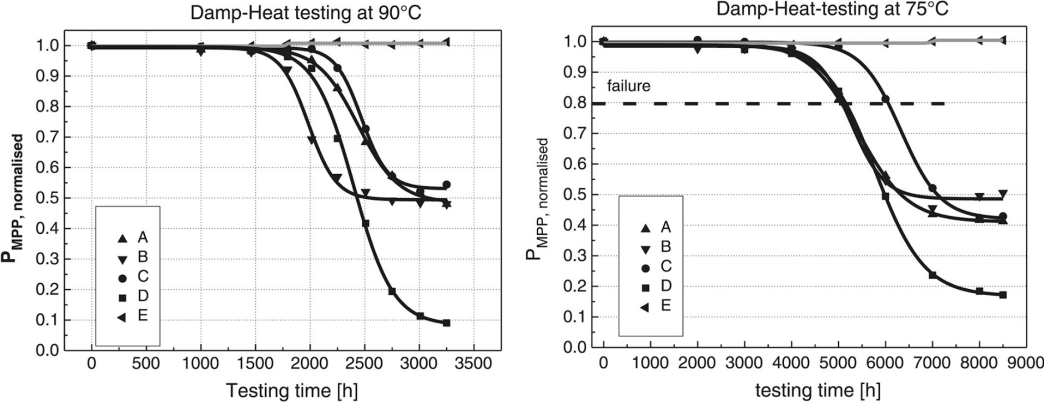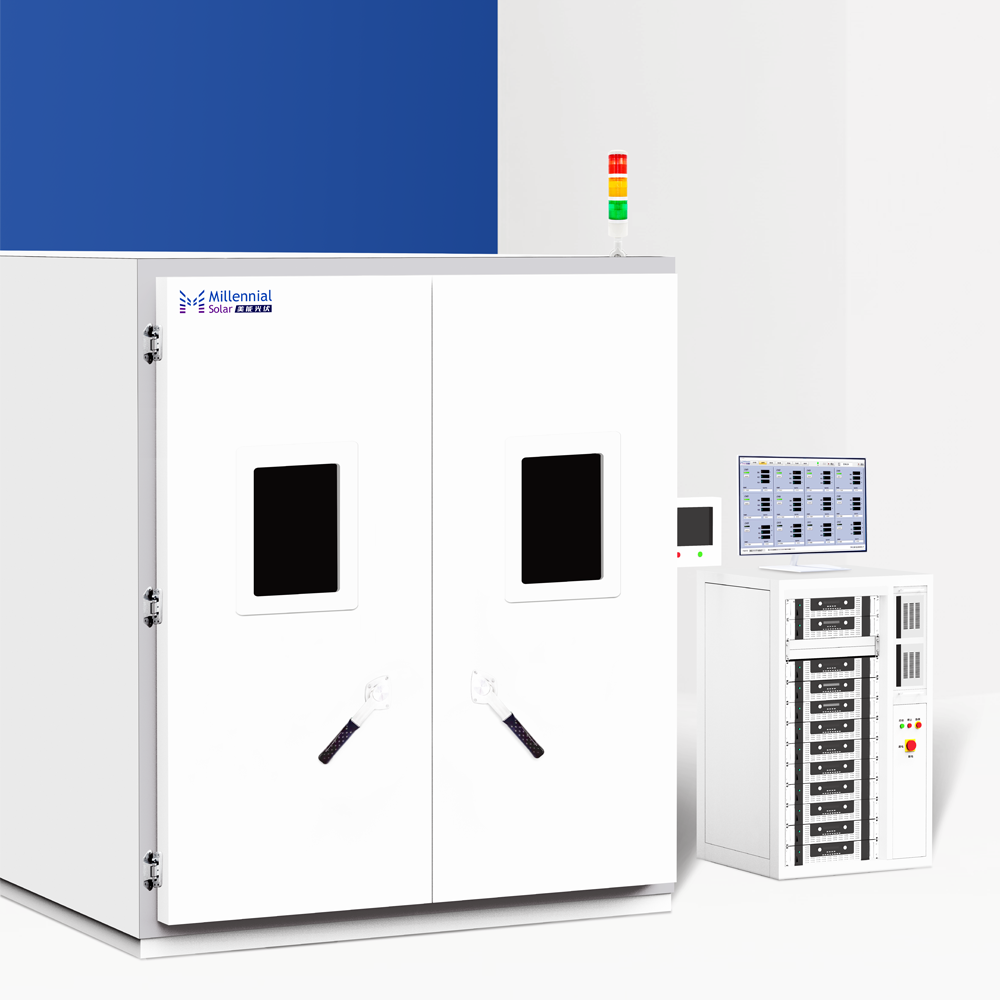
Quantum Efficiency Tester
PL/EL Integrated System
PV-Reflectumeter
3D Confocal Microscope
In-Line Four Point Probe Tester
Four Point Probe Tester
In-Line Thin Film Thickness Tester
Raman Spectrometer
FTIR Spectrometer
Spectrophotometer
Automatic Spectroscopic Ellipsometer
Contact Resistance Tester
Ultra depth of field 3D microscope
Auto Visual Tester
VMM PV Vision Measuring Machine
Solar Cell Horizontal Tensile Tester
Steady State Solar Simulator for Solar Cell
Solar Cell UV Aging Test Chamber
Solar Cell Comprehensive Tensile Tester
Visual Inspection Tester
Wet Leakage Current Tester
PV Module EL Tester
PV Module UV Preconditioning Chamber
Steady State Solar Simulator for PV Module
Current Continuous Monitor
Potential Induced Degradation Test
Bypass Diode Tester
LeTID Test System
Reverse Current Overload Tester
Impulse Voltage Tester
Hipot Insulation Tester
Ground Continuity Tester
Hipot Insulation Ground Tester
Damp Heat Test Chamber
Humidity Freeze Test
Thermal Cycle Test Chamber
Dynamic Mechanical Load Tester
Static Mechanical Load Tester
Hail Impact Tester
Robustness of Termination Tester
Module Breakage Tester
Cut Susceptibility Tester
Peel Shear Strength Tester
Universal Testing Machine (Single-arm)
Universal Testing Machine (Double-arm)
Glass Transmittance Tester
Acetic Acid Test Chamber
EVA Degree of Crosslinking Test System
Junction Box Comprehensive Tester
Drop ball tester
Semi-automatic scanning four-probe tester
Stylus Profilometer
Maximum Power Point Tracker
Perovskite Glass Transmittance Tester
Perovskite P1 Laser Scribing Multifunctional Testing Machine
Perovskite Online PL Tester
Perovskite Online Sheet Resistance Tester
Online Perovskite Film Thickness Tester
Perovskite Process Inspection Workstation
Portable IV Curve Tester
Portable EL Tester
Portable Thermal Imaging Tester
Solar Module Multi-Channel Testing System
PV Inverter Power Quality Tester
Drone EL Tester
IV Tester
IVEL Cell Sorting Machine
Damp Heat Test Chamber | Key Equipment to Ensure the Reliability of Photovoltaic Modules
Date : 2024-01-26Views : 215
With the increasing importance of renewable energy, solar photovoltaics have become an indispensable energy solution. However, photovoltaic modules face various environmental challenges in actual operation, such as high temperature and high humidity environments. In order to ensure the reliability and performance of photovoltaic modules, these harsh environmental conditions can be simulated through photovoltaic module damp heat tests. The Damp Heat Test Chamber from Millennial Solar complies with IEC international standards and related content, helping manufacturers better understand the performance and durability of photovoltaic modules.

What is damp heat test
Photovoltaic module damp heat test is a test that simulates the durability performance of photovoltaic modules in high temperature and high humidity environments. It can accelerate the evaluation of the reliability of photovoltaic modules in harsh environments and provide important data support. The International Electrotechnical Commission (IEC) has developed a series of international standards related to the damp heat test of photovoltaic modules, such as IEC 61215, IEC 61646 and IEC 61730. These standards stipulate the specific conditions, parameters and test methods of the test, ensuring the reliability of the test results.

Long-term photovoltaic module damp heat test data chart at 90℃ and 75℃
During the test, keep the test environment temperature at (85±2)℃, the relative humidity at (85±5)%, and the test time is 1000~1048 hours, depending on the research purpose. Long-term tests can provide more information about photovoltaic modules performance information. Keep the module in an open circuit state at a temperature of (23±5)°C and a relative humidity of less than 75%. After leaving it for 2 to 4 hours, check whether there are any serious appearance defects described in item 8 of IEC 61215-1, and conduct the wet leakage test should meet the same requirements as the initial test. After the test, conduct electrical performance testing of the photovoltaic modules, including efficiency, current output and voltage characteristics, to evaluate the functionality of the modules. Finally all the data is collected and analyzed. By comparing the data before and after the test, the performance changes of photovoltaic modules under high temperature and high humidity conditions are evaluated.

Electroluminescence images of modules with respect to damp heat test times
How the Damp Heat Test Chamber works
The photovoltaic module Damp Heat Test Chamber is a piece of equipment specially designed to perform damp heat tests. It simulates the working conditions of photovoltaic modules in a high-temperature and high-humidity environment, and tests it by controlling temperature and humidity parameters. The test chamber usually consists of a sealed test chamber, temperature and humidity control system, data acquisition system and safety measures. During the test, the module are placed in the test chamber, and the temperature and humidity control system provides the corresponding temperature and humidity according to the set test conditions. The test chamber will continuously maintain these conditions to simulate the high temperature and high humidity environment that photovoltaic modules may encounter in actual operation. At the same time, the data acquisition system will record parameters such as electrical properties and appearance changes during the test to evaluate its reliability and performance.
Damp Heat Test Chamber

E-mail: market@millennialsolar.com
Introduce:
Photovoltaic modules will withstand various harsh weather tests during their application. Among them, the performance of components such as their ability to withstand high temperatures, high humidity, and long-term moisture penetration needs to be evaluated. Hot and humid environment simulation tests are used to verify and evaluate the reliability of photovoltaic modules or materials, and to identify manufacturing defects early through thermal fatigue-induced failure modes.
Fulfill the standard:
IEC61215-MQT13; IEC61730-MST53
Features:
Continuous operation for more than 1,000 hours at 85°C and 85%RH requires ultra-high stability. The Damp Heat Test Chamber developed by Millennial is very high-quality in terms of manufacturing process and electronic equipment reliability.
•Built-in circulating air duct and long-axis ventilator for effective heat exchange, making the temperature inside the environmental box uniform and stable
•Adopt imported temperature controller to realize multi-stage temperature programming with high precision and good reliability
•Can operate in continuous high temperature and high humidity environment, and can also conduct high and low temperature interactive tests according to the engineering staff's plan
•With a potential-induced degradation testing machine, the performance of photovoltaic modules can be observed more intuitively
•Temperature fluctuation: ±0.5℃
•Humidity fluctuation: ±2.0%RH
Damp Heat Test Chamber can be used with Current Continuity Testing System

E-mail: market@millennialsolar.com
Introduction:
The Current Continuity Testing System mainly provides stable DC power, current recording, temperature recording and temperature control functions. Through temperature control of the DC power supply, it can monitor multiple currents and temperatures in real time for a long time. Cooperate with the environmental test chamber to judge the fatigue resistance of various raw materials, the rationality of the lamination process, and the stability of the welding quality of the photovoltaic modules in an environment where high and low temperatures are exchanged.
Fulfill the standard:
Meets the 10.11 High and Low Temperature Cycle Test Clauses and 10.12 Humidity and Freeze Test Clauses in the IEC61215 standard
Features:
•Adopt special heat dissipation channels to dissipate heat to ensure long-term uninterrupted operation of the equipment
•Use a stable constant current power supply to avoid overload and power outages caused by unstable internal resistance of photovoltaic modules under high and low temperature alternating conditions.
•The single-channel current control function required in the standard is improved, and the multi-channel current recording control function is adopted to realize the independent temperature control function of a single component
•Test data: Supports standard SECS/GEM protocol and RJ45 interface, providing open permissions and parameters.
Damp Heat Test Chamber is an important testing equipment in the photovoltaic industry. It accelerates the evaluation of the reliability and performance of photovoltaic modules by simulating high temperature and high humidity environments. The formulation and compliance with IEC international standards ensure the accuracy of test results. The equipment plays an important role in reliability assessment, product improvement, quality control and standard compliance, providing strong support for the development and promotion of the photovoltaic industry. As technology continues to advance, the Damp Heat Test Chamber from Millennial Solar will continue to play a greater role in promoting the sustainable development of the photovoltaic industry.

































































